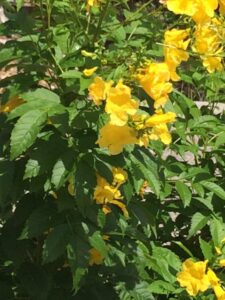 Esperanza, Tecoma stans, is native to Central Texas. Also known as Yellow Bells, Yellow Trumpetflower and Yellow Elder, this deciduous shrub is a darling of landscape designers. Both the native and cultivated varieties sport prolific showy yellow blooms and green foliage that is seldom browsed by deer. Its natural range extends from south Texas to Arizona, southern Florida and the Caribbean and south as far as northern Argentina.
Esperanza, Tecoma stans, is native to Central Texas. Also known as Yellow Bells, Yellow Trumpetflower and Yellow Elder, this deciduous shrub is a darling of landscape designers. Both the native and cultivated varieties sport prolific showy yellow blooms and green foliage that is seldom browsed by deer. Its natural range extends from south Texas to Arizona, southern Florida and the Caribbean and south as far as northern Argentina.
Esperanza thrives in full sun and grows to its full size, about 8’ tall and 5’ wide, with minimal interference from the resident gardener. It tolerates both dry and moderately moist soil and does best in rocky limestone, sand and loam. If spent blooms are deadheaded regularly, the flowering season will continue from summer though early fall. Cultivars provide a few color options such as shades of orange. To distinguish cultivated from native plants, observe the leaves. Cultivated plants have wider leaves with serrated edges and native plants have longer and more spear-shaped leaves.
Note wide leaves of cultivated Esperanza.

Note narrow leaves of native Esperanza.

Tecoma stans
The plant develops many long seed pods in late summer that contain around six seeds each. Seeds may be harvested for propagation after they turn brown. Soft wood cuttings can also be used for propagation. Even in the colder regions of the Hill Country, Esperanza will rebound in the spring. After the first heavy frost has killed back the foliage and before the spring growth appears, cut back the stems to 6 or 8 inches and new stems will regrow from the roots.
Bees and hummingbirds especially enjoy gathering nectar from the trumpet-shaped flowers. It is the larval host to the Dogface butterfly. Seed-eating mammals feed on the prolific seeds in fall.